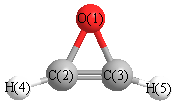All results from a given calculation for C2H2O (Oxirene)
using model chemistry: CCSD/daug-cc-pVTZ
19 10 17 12 22
States and conformations
| State |
Conformation |
minimum conformation |
conformer description |
state description |
| 1 |
1 |
yes |
C2V |
1A1 |
Energy calculated at CCSD/daug-cc-pVTZ
| | hartrees |
|---|
| Energy at 0K | -152.218395 |
| Energy at 298.15K | |
| HF Energy | -151.647364 |
| Nuclear repulsion energy | 61.574548 |
The energy at 298.15K was derived from the energy at 0K
and an integrated heat capacity that used the calculated vibrational frequencies.
Vibrational Frequencies calculated at CCSD/daug-cc-pVTZ
Geometric Data calculated at CCSD/daug-cc-pVTZ
Point Group is C2v
Cartesians (Å)
| Atom |
x (Å) |
y (Å) |
z (Å) |
|---|
| O1 |
0.000 |
0.000 |
0.888 |
| C2 |
0.000 |
0.634 |
-0.461 |
| C3 |
0.000 |
-0.634 |
-0.461 |
| H4 |
0.000 |
1.650 |
-0.790 |
| H5 |
0.000 |
-1.650 |
-0.790 |
Atom - Atom Distances (Å)
| |
O1 |
C2 |
C3 |
H4 |
H5 |
| O1 | | 1.4904 | 1.4904 | 2.3536 | 2.3536 |
C2 | 1.4904 | | 1.2671 | 1.0685 | 2.3072 | C3 | 1.4904 | 1.2671 | | 2.3072 | 1.0685 | H4 | 2.3536 | 1.0685 | 2.3072 | | 3.3001 | H5 | 2.3536 | 2.3072 | 1.0685 | 3.3001 | |
 More geometry information
More geometry information
Calculated Bond Angles
| atom1 |
atom2 |
atom3 |
angle |
|
atom1 |
atom2 |
atom3 |
angle |
| O1 |
C2 |
C3 |
64.844 |
|
O1 |
C2 |
H4 |
133.106 |
| O1 |
C3 |
C2 |
64.844 |
|
O1 |
C3 |
H5 |
133.106 |
| C2 |
O1 |
C3 |
50.312 |
|
C2 |
C3 |
H5 |
162.050 |
| C3 |
C2 |
H4 |
162.050 |
|
Electronic energy levels
Charges, Dipole, Quadrupole and Polarizability
